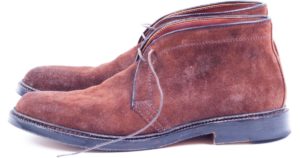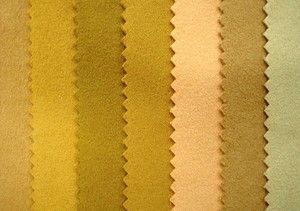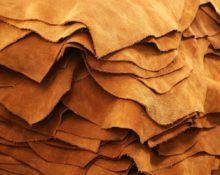Genuine leather is a practical material, wear-resistant, breathable and, with proper care, almost waterproof. Sometimes the thin top, most valuable layer of leather is used to sew high-quality products. It's called facial. Where does the rest go and what are the differences between these materials and suede? Read more about this.
What is a split?
During the processing process, the leather is sanded - divided into layers. Depending on the thickness of the animal’s skin, there can be at least 3, but no more than 6. They differ from each other in their properties and are intended for different purposes.:
 facial. This is the topmost layer. A distinctive feature is the natural measure - a natural pattern on the skin. It is used to make clothes and shoes, which will be sold labeled “genuine leather”;
facial. This is the topmost layer. A distinctive feature is the natural measure - a natural pattern on the skin. It is used to make clothes and shoes, which will be sold labeled “genuine leather”;- the middle layer from which the top and bottom are cut off. It’s called a split, that is, the two outer parts are cut off from the skin.. This material, essentially being genuine leather with rough sides, serves as raw material for sewing shoes, bags, aprons, gloves, and workwear. This layer is either covered with an artificial polyurethane coating with imitation mere, or a split-leaf velor is produced, which is often sold under the guise of suede shoes or accessories;
- mezdrovy, or bakhtarmyany. This is the bottom layer, which usually forms the basis for the production of various types of glue, technical gelatin and products for dissolving collagen fibers.
Important! Split leather with polyurethane or other coating applied on top is visually practically indistinguishable from genuine leather. This is widely used by unscrupulous sellers.
The price difference between leather and split leather products can be very significant. In the case of buying a bag made of split leather with polyurethane, which is passed off as genuine leather, only money is lost. But if boots are purchased from such material, this may lead to medical problems.
Of course, people buy and wear shoes, bags, and belts made of eco-leather, but it’s one thing when they are purchased consciously and without overpaying. The person is aware of all the positive and negative aspects of the purchase. Another thing is the sale of low-quality leather, a “semi-natural” product, as a high-quality item and at the same price.
In order not to fall for the bait of such “dealers”, remember how you can check the naturalness of the leather, even if it raises the slightest doubt:
- the inferiority of the product will be confirmed by two layers of material glued together;
- the peeling of paint on the skin indicates an artificial surface;
- When the sample is bent, the real skin straightens without deformation.
Pros and cons of shoe material
The middle layer of leather is used to produce artificially coated split leather for bags, belts, gloves and velor split leather, which is used for the production of footwear. Split velor, as a natural material, has undeniable advantages:
 luxurious appearance of the product;
luxurious appearance of the product;- comfort and ease of use;
- excellent air exchange;
- low price, which may differ from the cost of high-quality raw materials several times.
But there are also disadvantages, and they are very significant:
- During the process of roughening the skin, its structure is disrupted. Natural fibers are not preserved in the middle layer, which affects its elasticity. Split velor does not stretch well, it also does not restore its previous shape after force (impact, compression), and is less durable than high-quality material;
- Split velor has good thermal conductivity, which means that warm air from the boots can be discharged outside;
- moisture permeability of footwear;
- In PU leather, the artificial surface of the front side of the product can crack and peel off from the natural base.
Important! Caring for shoes made of split leather velor is the same as for shoes made of suede. Careful and regular treatment with protective, waterproof compounds improves the characteristics of the product, making the boots warm and waterproof to a certain extent.
Characteristics of suede
 Suede is a fairly expensive material. At its core - it's leather, but with two velvety sides. There is no regular face layer here.. This surface is produced using fat tanning from the skins of cattle - deer, chamois, goats, rams, and other small artiodactyl animals.Such raw materials for shoes initially imply a high cost, and as a result, the low prevalence of such products.
Suede is a fairly expensive material. At its core - it's leather, but with two velvety sides. There is no regular face layer here.. This surface is produced using fat tanning from the skins of cattle - deer, chamois, goats, rams, and other small artiodactyl animals.Such raw materials for shoes initially imply a high cost, and as a result, the low prevalence of such products.
Chrome suede, called velor, has become most popular among the population of our country. This material is produced using the same technology as suede, but the base is leather with defects on the front surface. Usually, for the outer surface, it is not a smooth measure that is used, but an inner mesh side, sanded to a thick, low, uniform pile. People call this particular variety suede, although this is not entirely true.
What are the benefits of suede shoes?
Natural suede and suede-velor have many positive qualities:
 soft, velvety surface;
soft, velvety surface;- ease;
- hypoallergenic;
- very attractive appearance;
- waterproof;
- elasticity;
- wear resistance;
- excellent breathability;
- preservation of heat inside the shoes.
Important! With careful use and careful care, suede shoes look luxurious and last a long time, but are not suitable for daily wear in urban environments.
What is the difference between suede and split leather?
From all of the above, it is clear that both suede and split leather are natural materials and are made from animal skins. The raw material for suede is whole leather, and for split leather it is a rough middle layer of leather, which is usually thinner than natural suede, and is also less elastic and durable. Suede and velor are much more expensive than products made from a treated middle layer.
How to distinguish shoes made of natural suede from shoes made of split leather?
The latest technologies allow manufacturers to dissemble and present cheap split leather as more expensive and high-quality suede.It is not always possible to distinguish them from each other, but there are still several ways:
 a suede product, slightly compressed (for example, in the area of the boot), quickly restores its original shape, while a cheaper split leather may remain bruised;
a suede product, slightly compressed (for example, in the area of the boot), quickly restores its original shape, while a cheaper split leather may remain bruised;- an absolutely flawless fleecy surface indicates that it has been processed with a knife, i.e. in front of you is a middle rough layer, split wood;
- the reverse side of the product has a not entirely uniform roughness with veins - in front of you is the front side of the skin from which suede or suede-velor was made.
Important! When using split leather shoes in dry weather or in an office environment, they will show their best side. It will last a long time and look very attractive.
In order not to fill the pockets of fraudulent sellers, refrain from expensive purchases of such shoes on the Internet sites of Chinese sites. Buy boots and shoes from a branded network of trusted manufacturers.


 facial. This is the topmost layer. A distinctive feature is the natural measure - a natural pattern on the skin. It is used to make clothes and shoes, which will be sold labeled “genuine leather”;
facial. This is the topmost layer. A distinctive feature is the natural measure - a natural pattern on the skin. It is used to make clothes and shoes, which will be sold labeled “genuine leather”; luxurious appearance of the product;
luxurious appearance of the product; soft, velvety surface;
soft, velvety surface; a suede product, slightly compressed (for example, in the area of the boot), quickly restores its original shape, while a cheaper split leather may remain bruised;
a suede product, slightly compressed (for example, in the area of the boot), quickly restores its original shape, while a cheaper split leather may remain bruised; 0
0





